“Apocalypse Now” – Unmasking the Colonial World
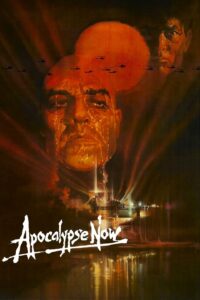
Title: “Apocalypse Now”
Release Date: 1979
Director: Francis Ford Coppola
Cast: Martin Sheen, Marlon Brando, Robert Duvall, Frederic Forrest, Albert Hall, Sam Bottoms
It seemed almost impossible to make this film: the budget was more than doubled, the production time increased five times, and the actor playing the main character almost lost his life. Despite this, “Apocalypse Now” has become one of Francis Ford Coppola’s most outstanding films and a masterpiece of war cinema. This multilayered story about the atrocities of the Vietnam conflict is at the same time a metaphorical journey into the soul of the main character and the whole world of Western civilization demonstrating its own superiority over other cultures.
“Apocalypse Now” – Conrad’s “Heart of Darkness” according to Coppola
“Apocalypse Now” is loosely based on Joseph Conrad’s novel Heart of Darkness. The story, which takes place at the end of the 19th century in Africa, has been transferred to the reality of the Vietnam War in the second half of the 1960s. The main character of the film is Captain Willard (played by Martin Sheen) who is entrusted by his commanders with a secret mission: the commando has to get to a small village on the border of Vietnam and Cambodia, where a distinguished officer of the American army, Kurtz (Marlon Brando), has created his own military state. Willard’s task is to exterminate Kurtz.
To do so, he and several young soldiers take an extremely dangerous journey upriver in a patrol boat. Along the way, he is escorted by Colonel Kilgore (Robert Duvall), a true “god of war” who announces the raid on local villages with the sounds of Richard Wagner’s Valkyrie Waltz, and in the midst of the military action prepares to windsurf on the sea waves. Willard takes advantage of the confusion on the battlefield to leave the half-crazed commander and travel onward.
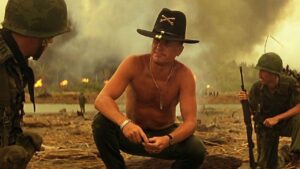
On the boat, the commando has the opportunity to read documents about Kurtz, which make him more and more consternation. He discovers that the great officer of the secret service has done a great service for the country, and his actions show his erudition and incredible sobriety of mind rather than the madness his superiors accuse him of. Misunderstood, Kurtz broke away from the army’s authority after ordering the execution of four men he believed were foreign intelligence agents. He then became the charismatic leader of the special unit he created and began conducting his own operations. Soon Willard receives news that his predecessor sent on an identical mission to kill a rogue officer has unexpectedly gone over to Kurtz’s side.
Meanwhile, the journey becomes increasingly dangerous, and the boat’s crew carries out an unnecessary massacre on random civilians they wrongly suspect of smuggling weapons. Only two of Willard’s companions reach the end of the journey, one of whom is murdered on Kurtz’s orders. The rebel colonel’s settlement looks truly sinister, with corpses hanging from trees, human heads pounding underfoot, and the local population seemingly in a hypnotic trance, controlled by the crazed Kurtz. Finally, after several days of imprisonment by the Colonel, Willard, feeling that Kurtz desires nothing more than death “by a dignified hand,” kills the officer and then sails away.
“Apocalypse Now” – the turbulent history of Coppola’s film
The history of “Apocalypse Now” has been extremely turbulent. It took more than 10 years from the birth of the idea for the screenplay to the time of production. The original version was created by John Milius, and the film was to be directed by George Lucas. When Coppola took over the project, he changed the meaning of the whole thing, and his critical edge towards America made no one want to help the project. Suffice it to cite the fact that the filmmakers had to borrow helicopters from the Philippines because the American military refused to cooperate.
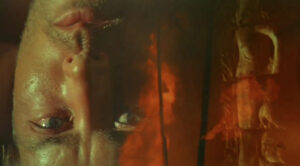
What is more, during the filming a typhoon and huge downpours raged in the Philippines, causing huge financial losses to the project. The budget was more than doubled (it was only possible to meet it because of the financing from Coppola’s own company), and the time of the project’s realization was prolonged five times in comparison to the original plans. As if that wasn’t enough, the actor playing the main role, Martin Sheen, took the tropical climate very badly. Exhaustion led the actor to a dangerous heart attack.
Nevertheless, the effect was worthwhile – “Apocalypse Now” became one of the most important works in the history of cinema and a gem of a war film. It won the Palme d’Or at Cannes, two Oscars (for cinematography and sound), three Golden Globes and two BAFTAs.
“Apocalypse Now” – the horror of a war god
“Apocalypse Now” is a film that emphatically shows the horror and absurdity of war – not just the one in Vietnam, but any war. War appears to be the cruelest experience a human being can face. It strips us of dignity, altruism, and empathy. War leads human minds and souls to destruction. It elevates pathological personalities such as Colonel Kilgore, whose character can be seen as the embodiment of the Mars archetype, the god of war. His meaningful name (“kill” means “to kill”) fully reflects the satanic ideas of this character.
Criminal attacks on civilians go hand in hand with his absurd ideas of using classical music during an attack or surfing in the background of loud explosions. By his own admission, he loves the smell of napalm in the morning, so he likes to use it to bomb enemy positions in the jungle. Kilgore is in his element in the war – he is boastful, arrogant, but also almost immortal. The character of the colonel has much in common with the cinematic image of another wartime commander – General Patton. Furthermore, she is a clear sign of the American arrogance that led to the loss of this war.
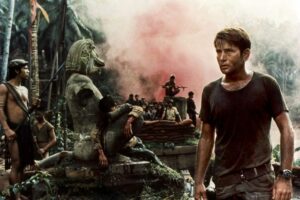
“Apocalypse Now” is a synthetic, well-constructed war film that shows its disastrous effects on many levels. The entanglement with evil doesn’t leave out ordinary young boys, who are put into uniforms to kill and survive at any cost. The scenes of an accidental massacre of Vietnamese on a boat and a chaotic fight without a commander on the Do Luc Bridge are very apt in this respect. The horror and absurdity of war are masterfully emphasized in the film by compositions of frames using light. Particularly the flashes of fire – at times ominous, at others resembling fireworks from a funfair. Also of great importance is the mood-building with the use of dim lighting and the play of chiaroscuro in Kurtz’s shots, bringing out the diabolical aspects of his character.
“Apocalypse Now” – a journey into the depths of the mind
At the same time, Coppola’s “Apocalypse Now” is a metaphorical story about Willard’s journey into his own inner self. This interpretation is already suggested by the film’s brilliant opening scenes. The image of the protagonist lying on his bed, immersed in gloomy thoughts, intertwines with shots of the burning jungle after a bombing, Kurtz’s scattered books, Willard’s upturned face juxtaposed with the stone face of a pagan deity from Kurtz’s village, and the ominous shadows of flying helicopters.
This masterfully edited prologue, showing the hallucinatory visions of the protagonist, is complemented by a poignant soundtrack – a song by The Doors and the lyrics of “The End” by Jim Morrison. It is hard not to admit that Vittorio Storar’s magnificent cinematography and Walter Murch’s music rightfully deserve the Academy Award. Willard’s journey goes deeper and deeper into the layers of his psyche, until he finally reaches the “heart of darkness” – a place where subconscious dark instincts prevail over what is rational and civilized. The wilderness (the heart of the jungle and the original tribe led by Kurtz) clearly prevails over culture here, which means the disintegration of the protagonist’s personality falling into madness as a result of his war experiences.
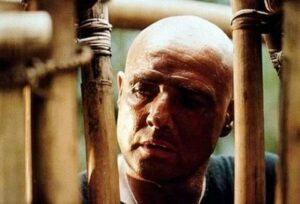
“Apocalypse Now” – postcolonialism
The water journey to Cambodia is also a sign of the destruction of the values on which all civilization is based. On the other hand, Western culture itself is treated extremely critically in “Apocalypse Now”. In this sense Coppola unmasks the colonial ideology, inherent in Joseph Conrad’s novel. “Heart of Darkness” was interpreted this way for the first time in 1977 by a Nigerian writer Chinua Achebe. He noted that Conrad identified with the thinking of white colonizers, who even treated Africa as an alien planet of non-humans.
In Coppola’s film the racial otherness of the Vietnamese, scornfully called, also reveals the hidden conviction inherent in the ideology of the West about the white man’s monopoly on full humanity. For American soldiers, the Vietnamese are not human even for a moment, but are a kind of pestilence that must be destroyed or subjugated at all costs. In a softened form, an identical attitude is displayed by the white French settlers with whom Willard spends the night. They are convinced that they have a right to own foreign land, and that their Vietnamese overlords are a mystery to them that is not worth delving into because evil surely lurks there.
Colonialism is also the belief that Western culture is superior to other civilizations and has a guiding role over them. How significant in this regard are the scenes of Colonel Kilgore “bombarding” the Vietnamese with European classical music (!). The Western sense of superiority can also be symbolized by Kurtz as a deity who craves power over the souls of the local tribes and who grants himself the right to construct his own morality. He is the one who decides from the top down what is right and what is wrong, and imposes the code of values he has set for others to believe. Kurtz, like Western civilization, has an ambivalent nature – he seduces with his erudition, knowledge, and rational argumentation, but at the same time he is filled with the wildest bloodthirsty instincts. He is not and does not want to be one of his fellow Asians, he always places himself “above” them. Therefore, he symbolizes the unsuccessful encounter of a Western man with the Other, in which, under the guise of fascination and desire for knowledge, there is a desire for power – the Other can only be killed or subjugated – this is the quintessence of colonialism.
Literature:
A.Garbicz, „Kino, wehikuł magiczny. Przewodnik osiągnięć filmu fabularnego. Podróż piąta 1974 – 1981”, Kraków 2009.
A. Burzyńska, M. P. Markowski, „Teorie literatury XX wieku”, Kraków 2006.
„Kino epoki nowofalowej”, pod red. T. Lubleskiego, R. Syski i I. Sowińskiej, Kraków 2015.

